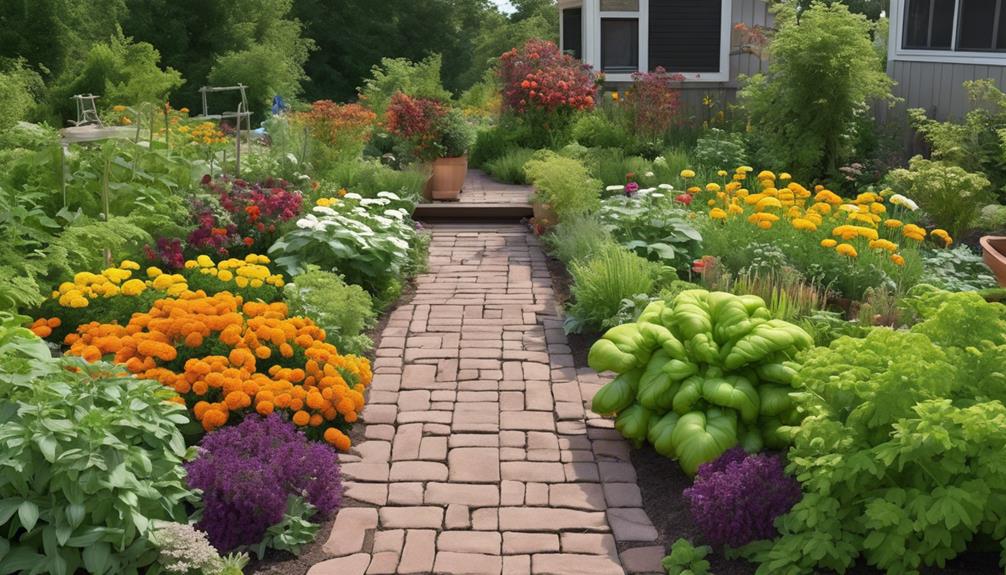Imagine your garden as a harmonious orchestra, each plant playing a crucial role in the symphony of growth and abundance. As you embark on the journey of companion planting, you’ll uncover the intricate dance of nature’s interconnected web.
But what happens when the wrong plant partners disrupt this delicate balance?
Stay tuned to discover how these 7 essential steps can transform your garden into a thriving ecosystem where plants support each other in ways you never imagined.
Select Complementary Plant Pairings
When designing your garden layout, integrating complementary plant pairings is a strategic approach that can significantly enhance the growth of your crops while naturally managing pest populations. This practice, known as companion planting, is more than just placing plants side by side; it’s about creating symbiotic relationships that benefit one another in various ways.
Companion planting serves multiple purposes. For instance, certain plants can attract beneficial insects that act as natural predators to common garden pests, reducing the need for chemical interventions. Marigolds, with their bright flowers, are well-known for repelling nematodes and other pests, making them excellent companions for carrots by creating a protective barrier against unwanted visitors.
Beyond pest control, companion planting can also involve selecting plants that offer mutual benefits in terms of physical support, microclimate regulation, or soil fertility enhancement. Tall plants like corn can provide shade for lower-growing, shade-tolerant plants, helping to protect them from the harsh midday sun. Similarly, legumes can fix nitrogen in the soil, enriching it for neighboring plants that require high nitrogen levels for growth, such as leafy greens.
When selecting plant pairings, consider the unique requirements and benefits of each species. For carrots, beneficial companions include onions and leeks, which can repel carrot flies, and leafy greens, which benefit from the loosened soil that carrot roots provide.
Experimentation is key in discovering effective companion plant pairings. Trial and error will reveal which combinations work best in your specific garden conditions, promoting a healthier, more productive garden ecosystem. By thoughtfully selecting plants that complement each other, you’re not just cultivating crops; you’re fostering a vibrant, self-sustaining garden environment that maximizes the potential of every plant.
Consider Plant Height and Spacing
In companion planting and garden design, an essential aspect to consider is the strategic arrangement of plants according to their heights and required spacing. This consideration is crucial for ensuring each plant receives sufficient sunlight and minimizing competition for essential resources such as water, nutrients, and space.
Taller plants, like corn or sunflowers, can serve multiple functions within the garden. They not only add structure and visual interest but also act as natural supports for climbing plants, such as beans, peas, or cucumbers, eliminating the need for artificial trellises. This vertical growth strategy can be particularly beneficial in gardens where space is limited, allowing you to maximize productivity within a smaller footprint.
Furthermore, thoughtful spacing and height considerations prevent taller plants from overshadowing shorter ones, ensuring that every plant receives the light it needs to photosynthesize effectively. For example, lower-growing crops like lettuce, which thrives in cooler conditions, can benefit from the partial shade provided by taller plants during the hotter parts of the day. This natural shading can extend the growing season of cool-weather crops and improve their quality and yield.
Optimal spacing between plants is equally important for maintaining good air circulation, which is critical for preventing fungal diseases and promoting overall plant health. Adequate spacing varies by plant species and should be adjusted based on their mature size and growth habits to ensure each has enough room to grow without competition.
By meticulously planning your garden layout with plant height and spacing in mind, you can create a balanced and productive ecosystem. This harmonious arrangement not only enhances the aesthetic appeal of your garden but also promotes healthier plant development, resulting in a more abundant and diverse harvest. Paying close attention to these details can transform your garden into a thriving, efficient space where every plant has the opportunity to flourish.
| Plant Height | Spacing | Benefits |
|---|---|---|
| Consider mature height to prevent shading | Proper spacing allows optimal air circulation | Taller plants can act as natural trellises |
| Group plants by height to avoid overshadowing | Optimal spacing reduces competition for sunlight | Strategic placement maximizes sunlight exposure |
Implement Pest-Repelling Plants
Consider incorporating pest-repelling plants strategically into your garden to naturally deter harmful insects and protect your crops. Here are some key plants to help you achieve this:
- Marigolds: Marigolds are not only visually striking with their vibrant orange and yellow blooms, but they also play a critical role in repelling nematodes – microscopic worms that attack the roots of vegetable plants. The secret lies in the marigold’s roots, which release a substance that is toxic to these pests. Planting marigolds around the perimeter of your garden or interspersing them among your vegetables can create a protective barrier against nematodes.
- Mint: Mint, with its strong fragrance, is a powerful deterrent against ants and cabbage moths. Its pervasive scent masks the smell of your crops, confusing pests and keeping them at bay. However, mint can be quite invasive, so it’s advisable to plant it in containers or confined spaces to prevent it from overtaking your garden.
- Nasturtiums: Nasturtiums are not only edible and decorative but also serve as a magnet for aphids, drawing these pests away from other plants. By planting nasturtiums strategically around your garden, you can use them as a sacrificial crop, protecting your vegetables from aphid infestations. Additionally, nasturtiums can attract beneficial insects like ladybugs, which feed on aphids, further enhancing your garden’s natural pest control.
- Sage: Sage is another herb known for its pest-repelling properties, particularly against cabbage moths, which can be detrimental to cabbage, kale, and broccoli plants. Planting sage near these crops can help to safeguard them from damage, as its aromatic leaves are unattractive to cabbage moths.By integrating these pest-repelling plants into your garden layout, you not only enrich the biodiversity of your garden but also employ a proactive approach to pest management. This method promotes a healthier, more balanced ecosystem, allowing your crops to thrive without the need for synthetic pesticides. Experiment with these and other pest-repelling plants to discover the best combinations for your garden’s unique needs and conditions.
Incorporate Nitrogen-Fixing Plants
Rotate Crops Strategically
Strategic crop rotation is a fundamental practice in sustainable gardening that enhances soil health and boosts garden productivity by managing nutrient balance, breaking pest and disease cycles, and improving soil structure. By rotating crops according to their specific family groups, you can prevent the depletion of soil nutrients, reduce the buildup of pests and diseases associated with certain crops, and ensure a healthy, thriving garden. Here are detailed strategies to effectively implement crop rotation in your garden:
- Prevent Soil Depletion: Different plants have varying nutrient requirements. By rotating crops, especially between heavy feeders (such as tomatoes and corn) and light feeders or nitrogen-fixing plants (like peas and beans), you can manage and maintain the nutrient balance within your soil. This rotation helps avoid the exhaustion of specific nutrients, ensuring that soil fertility is preserved for future planting seasons.
- Reduce Pest and Disease Risks: Many pests and diseases tend to target specific plant families. By rotating crops based on their families (e.g., Solanaceae, Brassicaceae, Fabaceae), you can disrupt the lifecycle of pests and pathogens, significantly reducing their presence in your garden. For instance, if you’ve planted tomatoes (Solanaceae family) in one area, rotate to a crop from a different family, such as beans (Fabaceae), the following year to deter tomato-specific pests and diseases.
- Maximize soil health: Incorporating a diverse range of plant families into your rotation plan can lead to improved soil structure and health. Each plant family has different root structures and growth habits, which can affect soil aeration, moisture retention, and microbial diversity differently. By rotating crops, you encourage a rich, diverse soil ecosystem that supports robust plant growth.
- Break pest and disease cycles: Crop rotation is crucial for interrupting the cycles of pests and diseases. Many of these organisms survive in the soil or on crop residues from one season to the next. Rotating to a crop that is not susceptible to the same pests or diseases can starve out the problem organisms, effectively reducing their numbers and impact on subsequent crops.
- Implementing Effective Crop Rotation:
- Plan Ahead: Map out your garden and plan rotations for at least three to four years to avoid repeating the same crop family in the same area.
- Keep Records: Document what you plant and where each season to track rotations and make informed decisions for future planting.
- Consider Crop Needs: Balance nutrient-demanding crops with those that improve soil fertility, such as legumes, which fix nitrogen in the soil.
By embracing these strategic crop rotation practices, you not only enhance your garden’s productivity and sustainability but also contribute to a healthier environment by minimizing the need for chemical fertilizers and pesticides. Strategic rotation fosters a balanced, nutrient-rich soil that supports vibrant, healthy plant growth, leading to bountiful harvests year after year.
Utilize Companion Planting Charts
To further optimize your garden’s health and productivity, start by utilizing companion planting charts to strategically pair your vegetables with suitable companions. Companion planting charts provide valuable information on beneficial plant pairings, helping you enhance growth and productivity while creating a balanced garden ecosystem. By following these charts, you can attract beneficial insects, repel pests, and improve overall garden health. Here is a simple example of how companion planting can work for you:
| Vegetables | Suitable Companions |
|---|---|
| Tomatoes | Basil, Carrots |
| Cucumbers | Peas, Radishes |
| Lettuce | Beets, Carrots |
Monitor and Adapt the Garden Plan
Frequently Asked Questions
What Are the Basics of Companion Planting?
To understand the basics of companion planting, consider the benefits like improved nutrient uptake and pest management. Planting different species together can help increase vegetable yields and create a balanced ecosystem in your garden.
What Are the 10 Steps to Planting a Garden?
To plant a garden successfully, start by choosing the right spot with good sunlight. Prepare the soil by removing debris and adding compost. Plant your seeds or seedlings at the right depth and water them regularly for healthy growth.
What Are the 4 Things to Remember When Planting a Garden?
When planting a garden, remember to consider sunlight needs, rotate crops yearly, use diverse companions for natural pest control, and monitor plant health. These steps ensure a thriving garden ecosystem for your plants.
Which Vegetables Should Be Planted Next to Each Other?
Planting tomatoes next to basil creates a dynamic duo that wards off pests and boosts growth. Pairing vegetables strategically like dill with tomatoes or borage near other plants enhances flavor, attracts beneficial insects, and promotes a thriving garden ecosystem.
Conclusion
Now that you’ve learned the key steps for a successful companion planting garden, remember that every seed you sow is a story waiting to be told.
So go ahead, mix and match your plants like a painter with their palette, creating a masterpiece of color, texture, and flavor in your backyard garden.
Happy planting and may your garden bloom with harmony and abundance!





